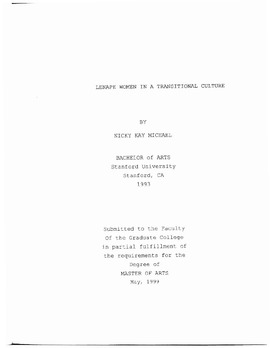| dc.description.abstract | The story of the Lenape is one example of adaptation and survival, and Lenape women held a prominent role in the process. Lenape women that retain knowledge of their heritage hold a significant perspective to view the ramifications of their traditional values of their culture from which Lenape women made socioeconomic contributions to a transitional traditional culture. Lenape customs of the Big House, Doll Dance, social dances, stomp dances, drums, Native American Church, funerals, feeds, festivities, etc. imbued the Lenapes with their identity as a community. In turn, the people perpetuated the existence of their customs each time they re-enacted them. While the forums from which the customs were re-enacted may have changed, the basic premises, or Lenape worldview, allowed the people to regenerate the Lenape culture. Lenape women participate in significant activities that continue and re-instill this worldview and thus Lenape women actively participate in a transitional culture. As culture is not static, current Lenape culture can not totally be the same as it was in precontact or early contact history. Within the domains that they could control, however, family, religion, and culture, Lenape women modified their internal society clinging to as many of the former customs as possible, while creating additional and yet, culturally appropriate mechanisms to adjust to a foreign system of land ownership and Euro-American society in general. The allotment process altered Lenape customs by overturning Lenape women's socioeconomic status, thus reducing the extent of Lenape women's abilities to subsist and adapt to their new circumstances in Indian Territory, as they had previously been able to do in removing to former areas. The purpose of the Dawes and Severalty Act, 1887, was to break down the communal and tribal patterns of Indian life to impose White standa.rds of social organizational behavior. The act, even more than removals, attacked the fundamental elements of Lenape life. The Delaware Nation retained, redefined, and transformed their tribal culture in spite of the imposition on their lives. Much was retained, but the position of th8 Lenape women was forever changed. Dependent on the control of tribal land, women's roles in Delaware society had to adjust to the laws of privatization. Traditionally, through their dreams and metaphysical experiences, Lenapes connected to their ancestors, who in turn, revealed how the Lenape people should live today. The Lenape adapted with each move west as well as accommodated to the allotment and 'civilizing' forces. Their last adaptation will include the transition from a survival and protective mode to a fully functional and flourishing society. | |
